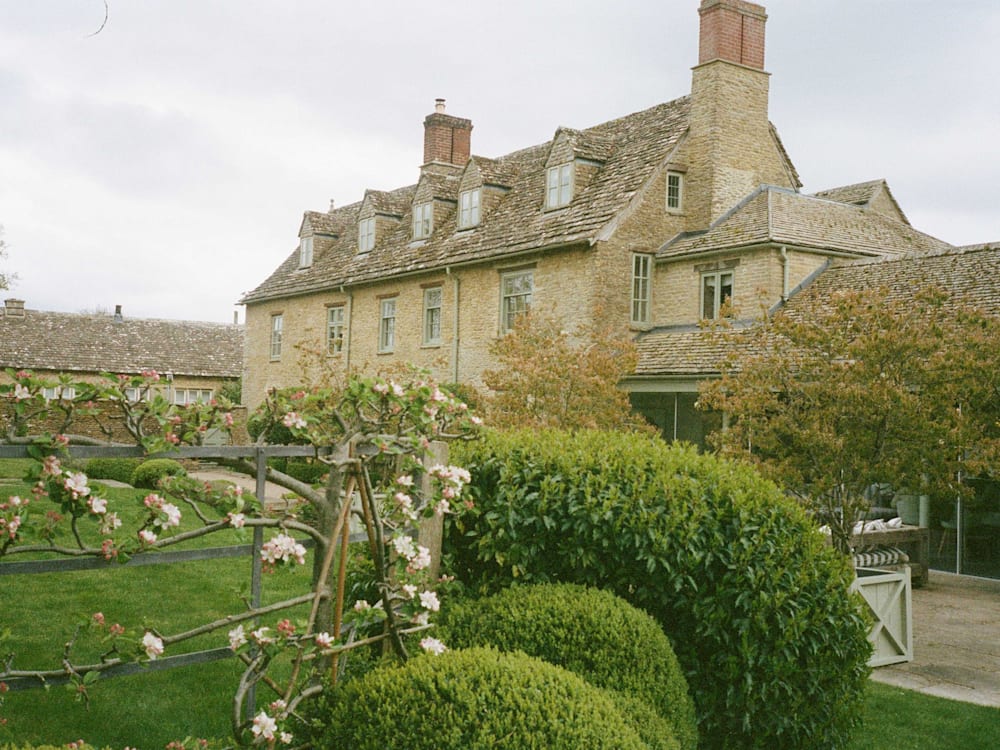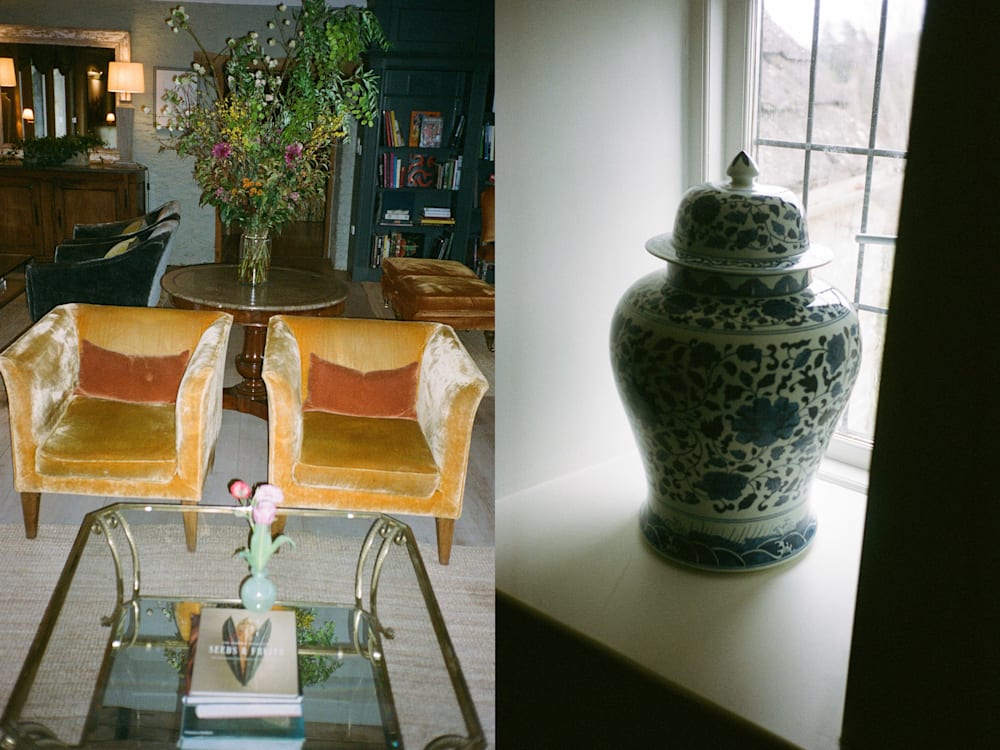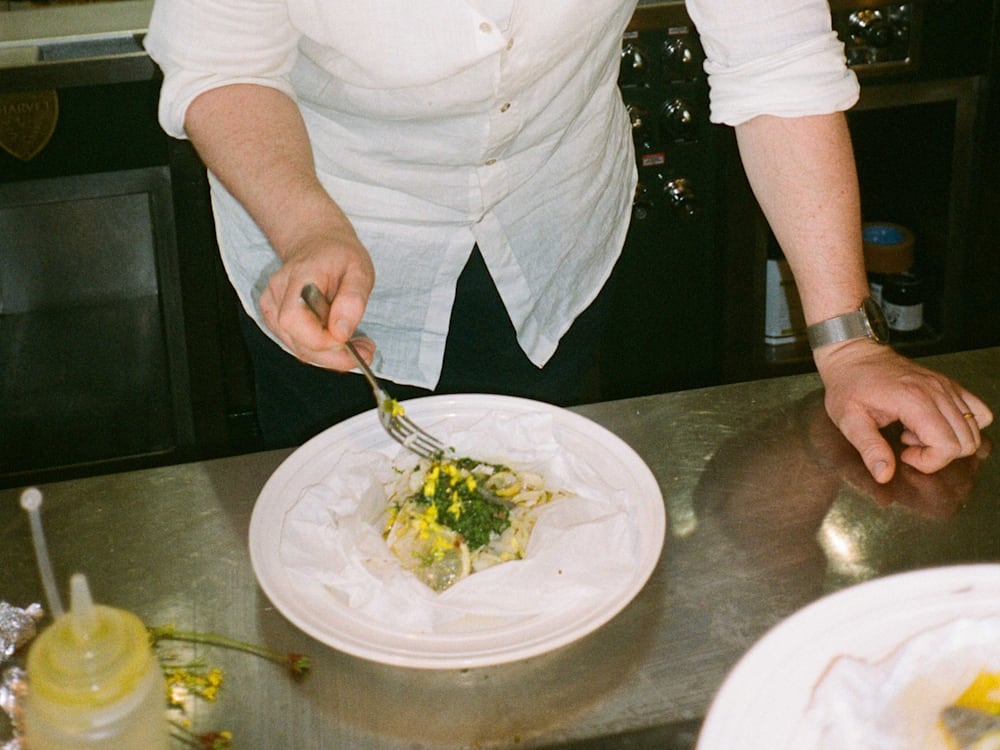Let us introduce you to the world’s most exciting hotel chefs as we guide you through the gourmet getaway spots we’re hungering for…
WHO’S IN THE KITCHEN?

Charlie Hibbert finessed his craft at legendary London eatery Quo Vadis, but his family seat is the enchanting Cotswolds village of Southrop. It’s here where the Hibberts developed Thyme, more akin to a village than a hotel, bringing vintage farm buildings back to life and Charlie back into the fold to run the Ox Barn restaurant. As it gained a reputation for food swayed by the seasons, he then took charge of local pub The Swan (where he worked as a pot-washer as a teen) and spa-adjacent eatery The Orchard House.
WHAT’S COOKING?
This is a chef besotted with his kitchen garden — rightly so, as there’s a cornucopia of produce to be found in the beds, orchards, hedgerows and beyond. In fact, it’s the garden that dictates the menus here, meaning cookery is seasonal to the day. Dishes such as nettle velouté with asparagus or roast chicken with wild garlic might reflect the setting’s rusticity, but more than a little of Quo Vadis’s urban sophistication is evident too.
RECIPE FOR SUCCESS

Aside from his stint in London and ongoing successes in the Cotswolds, Hibbert has trained internationally at Ireland’s Ballymaloe Cookery School, run by slow-food pioneer Darina Allen; and New Zealand’s Craggy Range Winery, where he was schooled in excellent local and Aussie wines.
Your family has evolved the Thyme estate into one of the most enchanting places to stay in the Cotswolds. What are the joys and challenges of helping to run a family business?
It’s a wonderful thing to be involved in the collaborative and creative efforts that go into making Thyme what it has become and to see where it will be going. [As for the challenges], family meals can end up becoming a bit of a meeting, so sometimes a bit of effort needs to be made to keep everyone on track.
Thyme’s kitchen garden and orchards provide fruit, vegetables and herbs to the hotel’s restaurants — what’s the process of planning the produce and menus?
At the beginning of the year/growing season, Head Gardener Daryll Taylor and I review what worked and did not work in the garden the previous year, and anything new we have found that piques our interest. Then Daryll updates us with what’s available in the garden, and we create our menu around the produce in season, alongside other inspiring ingredients from our great local suppliers: cured meats from Salt Pig, beef and pork from Huntsham Farm, and Cacklebean eggs from Cackleberry Farm.
What’s the biggest challenge in crafting a menu that balances changing seasons and modern flavours?
The menus are very much led by what we can harvest from the garden, which gives us a framework [to work with]. The challenge comes more from the growing effort: the picking, cleaning and cooking of the food, and all the care and man hours that the team puts into everything we do.
Is there any dish on your menus that has a personal story or significance behind it?
You will often find meringues on our menus, as meringues were my favourite dessert growing up. My grandmother on my mother’s side made a top-drawer pavlova, which was topped with rhubarb or poached pears, cream, ice cream and pistachios, almonds and hazelnuts.

What are your top tips for aspiring foragers?
Make sure you know what you are picking. Start with the simple things, like wild garlic and elderflower, and don’t take too much — always leave something for our wild friends. You could also take a course; there are many available across the country and they’re always fun and fascinating.
Tell us how you helped to build the stellar reputations of the Ox Barn, The Swan Pub and The Orchid House.
Our reputation has been built through careful thought and a careful eye on making Thyme great as it can be. We hope everyone on this journey with us is motivated to make the hotel a continued success and ensure our guests are relaxed, well fed and watered.
[To do this, we’ll continue to] focus on the flavour and simplicity of dishes, pick ingredients that speak for themselves, and collaborate with the rest of the family.
You’ve travelled extensively, first working at the Ballymaloe Cookery School in Ireland, hopping from India to Vietnam, Malaysia and the Philippines, then working at Craggy Range Winery in Hawke’s Bay New Zealand. How have your travels shaped the way you approach cooking?Experiencing food around the world was a wonderful experience, and I found some real gems. I loved Four Horsemen in Brooklyn, a small-plates wine bar owned by James Murphy of LCD Soundsystem; chef Alice Waters’ farm-to-table joint Chez Panisse in San Francisco; and Black Barn vineyard and bistro in Hawke’s Bay, New Zealand. I found a home there and loved living and working in and around the wineries — working at Craggy set me on the path into kitchens and [working with] food.
And what were your favourite meals you ate while travelling?
One memory that springs to mind is of a wonderful red fish curry I had in the Kerala backwaters, after being invited into a homestead. I’ve always wanted to recreate it; however [when the recipe was shared], the language barrier meant I’ve never quite been able to [get it right].
[I also loved] the desserts Irish chefs Darina Allen and Rory O’Connell made at Ballymaloe House, especially Carrageen moss pudding — made using a type of seaweed — that I had to make for my exams. The wonderful seafood dishes and fresh pawpaw I had in New Zealand; and the most delicious home-cooked fish curry in India.

Which restaurants do you most miss in London?
Quo Vadis, obviously, as it was my home for six years; and I have a love for Ducksoup and Trullo. The many lovely late-night dinners at Terroirs, too, which has sadly closed its doors, and Frank’s Cafe & Campari bar for sunny summer days.
What was the best advice legendary Quo Vadis chef Jeremy Lee gave to you while you were working with him?
Jeremy’s way of working was so inspiring. With the mountains of beautiful vegetables and ingredients coming into the kitchen, from the likes of biodynamic farm Fern Verrow and pork from Richard Vaughan’s family-run Huntsham farm, we were always encouraged to use the best of what we had in the fridge.
Tell us about the sustainability efforts at Thyme in the restaurants and beyond, and its importance to the hotel.
Part of the charm of Thyme is the restoration work that’s gone into it — we spent 15 years renovating the working buildings which have serviced the surrounding land for centuries. Taking them on, plus the fields, comes with a responsibility [to the land and history] that we want to meet — it’s something that’s woven into the fabric of Thyme. From a kitchen viewpoint, all of our food waste goes into an anaerobic digester and we take on whole carcasses in the kitchen, treating the animals (who live long lives and are well looked after) with a nose-to-tail philosophy.
Do you think plant-based diets are the future, or is it better instead to develop more sustainable methods of farming meat?
I believe animals have a place in farming rotation and in our society. We need to move away from horrible methods of farming, such as using cages and mass production, and treat animals with respect, especially when they have made their way into our kitchens.
Aside from the kitchen, where is your favourite place to be at Thyme and why?
Walking along the river and in the kitchen garden — simply being in the grounds of Thyme. It’s a wide-open playground for my young family and a place where you can find a bit of peace, if and when needed.
Which Cotswolds-grown ingredient do you most enjoy working with, and what’s your favourite way to use it?
Wild garlic and nettles in spring, which grow on our doorstep. We pound them into pesto, chop them into risottos and blitz them into soups and sauces. Or anything that we find in the hedgerows: cobnuts, walnuts, mirabelle, greengage and bullace.
QUICK-FIRE ROUND

You can hop to three countries for breakfast, lunch and dinner — where are you going?
For breakfast I’d have croissants and coffee in Paris, France; for lunch I’d have orecchiette and cimi di rapa in Italy; and for dinner, I’d have tapas at Cal Pep in Barcelona.
You’ve been tasked with creating an in-flight menu. What’s on there?
Peposo (an Italian beef, tomato and peppercorn stew) and polenta. But I’m a take-my-own-sandwich-and-snacks man, really; plus, I tend to go veggie on flights.
You’ve snuck some minis onto the plane. What cocktail are you making?
Vodka martini, dry with a twist of lemon — after two or three you’ll sleep soundly.
Room service: what are you ordering?
Caesar salad and chips.
Which dish instantly transports you home?
Steak au poivre with lots of anchovy. Mum used to add Gentleman’s Relish anchovy paste — good stuff.
Which dish from your travels do you wish you’d created?
In Italy I had these really beautiful fagiolini pinti (snake beans), cooked with tomato sauce and ricotta salata.
What’s your guilty-pleasure holiday treat?
Eating and drinking alone in a restaurant. Some disagree, but if I can escape, I love it.
Favourite restaurant for blowing the budget?
Noble Rot in London on Beaujolais day and everything that comes with it.
TIME TO SERVE

Learn how to make Charlie Hibbert’s springtime fish dish.
Ingredients
– 1 fillet of sea bream
– 4 pink-fir potatoes
– Half a head of fennel
– Half a lemon, zest and juice
– 1 tablespoon of butter
– 80ml dry white wine
– A pinch of chilli flakes
For the salsa verde
– A small handful of parsley, chopped
– 2 anchovies, chopped
– 1 tablespoon of capers, chopped
– 1 small clove of garlic, peeled and grated
– Salt and pepper
– Olive oil
Place the potatoes into cold salted water and bring to the boil for 15 minutes or until they are cooked through. Drain and peel them when they’re cool enough, then keep to one side.
Slice the fennel into thin strips and blanch in boiling water for four to five minutes, then drain and set to one side.
Tear off a square of tinfoil and lay it flat on your worktop; this needs to be large enough to wrap the whole fish. Tear off a slightly smaller square of baking parchment and lay it on top of the tin foil. Place the fish onto the parchment and season with salt and pepper, then add the fennel, lemon, chilli and butter before folding up the sides of the foil to form a bag, leaving a little spout at the top. Pour the wine into the spout, then place the fish into a preheated oven and cook for 15 minutes.
Combine all of the salsa verde ingredients together, then drizzle over the olive oil. Pour the salsa verde over the potatoes and serve alongside the steamed fish.
Bon appetit!
If that’s whet your appetite, now explore our other Yes, Chef interviews



